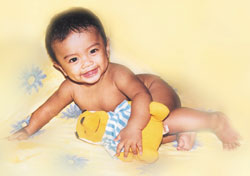|
by Gavin JONES and P C WONG

 n the early 1960s, the average woman in Singapore bore six children. By 1975, this had dropped to 2.1 - the replacement level - one of the most rapid fertility declines in world history. Subsequent fertility fell even lower. If women continue to produce children at the rate they did in 2003, 100 women will on the average produce only 126 children, about half of them females. At this rate of fertility, each generation of females will be 36% smaller than the previous generation. n the early 1960s, the average woman in Singapore bore six children. By 1975, this had dropped to 2.1 - the replacement level - one of the most rapid fertility declines in world history. Subsequent fertility fell even lower. If women continue to produce children at the rate they did in 2003, 100 women will on the average produce only 126 children, about half of them females. At this rate of fertility, each generation of females will be 36% smaller than the previous generation.
The issue of declining fertility is of major concern in Singapore, but the island republic is not alone in facing this disturbing trend. Western countries, as well as large swathes of East Asia and Southeast Asia, have seen fertility plunge to very low levels, the continuing of which will lead to ongoing declines in population.
To adapt the dramatic "population explosion" language used to describe the upsurge in population growth in the second half of the 20th century, these regions now face a "population implosion" - an accelerating drop in population, resulting from continuing low fertility levels and smaller cohorts (themselves the result of earlier declines in fertility) reaching reproductive age.
There are competing theories about why fertility has fallen in Singapore and many other countries. Many of these focus on changing assessments, not only by married couples of the cost and benefits of having children, but also of many young adults of the wisdom of marrying in the first place. In many Western countries, marriage is no longer a necessary requisite to having children, but in Asian countries childbearing outside marriage remains rare. In the latter, therefore, factors affecting marriage directly translate into factors affecting childbearing.
Life choices for women have become more complex in recent times. Educational and employment opportunities for women have expanded enormously, but many of these opportunities, to be fully seized, require a pattern of commitment to work that does not easily accommodate the demands of childbearing and childrearing. Neither the organisation of the workplace nor the attitudes of men as husbands or employers make it easy for women to combine formal-sector work with homemaking work, so it is not so difficult to understand fertility’s sharp decrease in so many places.
Although declining fertility results mainly from conscious choice, 10–15% of the population experiences involuntary infertility. Many in this group would like to have the children they cannot produce. As couples delay childbearing, the effects of age on fertility become significantly more important. Research shows that an increase in age corresponds to a decrease in fertility. The risk of endometriosis, polycystic ovarian disease, and genetic disease also rises. Problems in adolescence may continue into adult years and impact on later fertility.
Women with fertility problems stand to benefit greatly from advances in science and medicine that have enabled doctors to treat them. New developments in assisted reproductive technology may enable childless couples to conceive. Refinements of present techniques, complemented with holistic approaches, have also resulted in higher pregnancy rates in infertile couples. Even for people who risk passing on hereditary diseases, all is not lost; state-of-the-art genetic diagnosis screens embryos to prevent affected births.
At the same time, progress in the pharmaceutical industry has improved, producing better gonadotrophins and drugs used in reproductive treatment. Increasingly sophisticated medical diagnostics and devices also help to ensure the monitoring and delivery of healthy babies. With better and more open communication, awareness is growing that people’s sexual behaviour will impact the fertility rate.
This issue of INNOVATION provides an overview of what has been happening and why, with regard to behavioural determinants of fertility as well as to developments in science and medicine that are improving prospects for many infertile couples. It also looks into the implications of these trends and the many policy issues that consequently arise.
 Click here to download the full issue for USD 6.50 Click here to download the full issue for USD 6.50
|



 n the early 1960s, the average woman in Singapore bore six children. By 1975, this had dropped to 2.1 - the replacement level - one of the most rapid fertility declines in world history. Subsequent fertility fell even lower. If women continue to produce children at the rate they did in 2003, 100 women will on the average produce only 126 children, about half of them females. At this rate of fertility, each generation of females will be 36% smaller than the previous generation.
n the early 1960s, the average woman in Singapore bore six children. By 1975, this had dropped to 2.1 - the replacement level - one of the most rapid fertility declines in world history. Subsequent fertility fell even lower. If women continue to produce children at the rate they did in 2003, 100 women will on the average produce only 126 children, about half of them females. At this rate of fertility, each generation of females will be 36% smaller than the previous generation.
 Click here to download the full issue for USD 6.50
Click here to download the full issue for USD 6.50